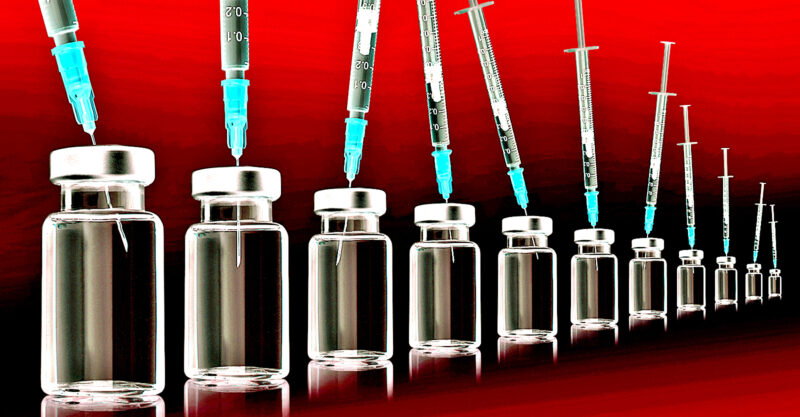Miss a day, miss a lot. Subscribe to The Defender's Top News of the Day. It's free.
Two-and-a-half years ago, the Grand Poobahs of global vaccinology admitted — in behind-closed-door confessions caught on camera at the World Health Organization (WHO) — that public and professional confidence in vaccines was “wobbly,” and deservedly so.
As the gathered experts conceded, the glaring inadequacies of vaccine safety science and the dysfunctional safety monitoring systems that permit routine “obfuscation” of serious adverse events were understandable reasons for public distrust.
At the time, it seemed as though such momentous disclosures would presage a death knell for vaccine “business as usual” — but then along came COVID-19, and with it, the instant memory-holing of the WHO’s stunning admissions.
Rather than finally address the self-confessed vaccine disaster, public health officials and global leaders — ranging from presidents to private-sector employers to top military brass to central bankers — used COVID-19 as an opportunity to double down in the opposite direction, forcibly stuffing the “vaccine hesitancy” genie back in the bottle with ethically untenable vaccine mandates.
After 18 months of force-feeding the COVID-19 jabs, however, manufacturers are now discarding tens of millions of doses “amid sagging demand.”
In some respects, this could be construed as evidence of policy failure, but the fact is that the COVID-19 shots accomplished a significant goal for the parties that pushed them, launching a renewed vaccine gold rush that — with growing emphasis on voguish, biotech-reliant biopharmaceuticals — seems likely to extend well beyond the COVID-19 era.
As the head of Bayer’s pharmaceuticals division observed in late 2021, mRNA vaccine technology and other forms of cell and gene therapy — for all of their by now well-documented and even species-threatening dangers — have crossed over both the regulatory and public palatability threshold.
Pfizer, Johnson & Johnson (J&J), AstraZeneca, Sanofi and Eli Lilly — some of major players in the biopharma space — are actively prioritizing “strategic alliances” and “collaborations to expand their [biopharmaceutical] product portfolios.”
Meanwhile, the U.S. Food and Drug Administration (FDA) and Centers for Disease Control and Prevention (CDC) are poised to roll out, at breakneck speed, approvals and recommendations for whatever new childhood and adult vaccines are sent their way.
In short, using technologies both “conventional” and new, a multipronged effort is afoot to jump-start and ensure a frenzied vaccine-palooza.
The mRNA pipeline
Having succeeded in foisting COVID-19 mRNA injections on an initially unsuspecting public, manufacturers and government agencies like the National Institutes of Health (NIH) are now salivating at the prospect of an endless series of mRNA vaccines.
It is no coincidence that the mRNA jabs in the works target some of the very conditions being reported as COVID-19 vaccine adverse events, a neat “create-a-problem, develop-a-drug-to-manage-the problem” trick that accounts for many other drugs already on the market.
In the pipeline are mRNA vaccines for the following:
- Cancer: Researchers are conducting dozens of clinical trials to test “mRNA treatment vaccines in people with various types of cancers.” Dr. Ryan Cole, a pathologist, described the dramatic surge in endometrial and other cancers following the rollout of COVID-19 shots.
- Shingles: Cole and others also noted the uptick of shingles in COVID-19 vaccine recipients. Moderna in March announced its development of an mRNA shingles vaccine, as well as mRNA vaccines for herpes and cancer.
- Other forms of immune suppression: With numerous indications that COVID-19 shots are reprogramming the immune response, officials and manufacturers are dusting off HIV as the supposed bogeyman. Moderna and NIH are partnering in mRNA vaccine clinical trials for HIV. This would represent a particular coup for Dr. Anthony Fauci, who over four decades has found development of an HIV vaccine to be “a daunting scientific challenge.”
- Heart attacks: Cardiac problems are among the few COVID-19-vaccine-related adverse events grudgingly acknowledged by manufacturers and the FDA. In the U.K., researchers are investigating the use of “exactly the same technology as the Pfizer and Moderna vaccines to inject micro RNAs to the heart,” claiming they can get whatever heart cells survive after a heart attack to proliferate.
- COVID and influenza: Manufacturers also are gearing up for a new generation of mRNA-based flu shots and mRNA combination vaccines which, they promise, will “protect against several different infections at the same time, such as influenza, COVID-19 and other respiratory infections.”In the meantime, CDC just recommended that seniors (aged 65 years or older) receive “enhanced” flu shots — either high-dose, adjuvanted or recombinant — in lieu of “standard-dose unadjuvanted, inactivated vaccines.” Adjuvanted influenza vaccines feature a new generation of “smart” vaccine adjuvants designed to ensure even the most mediocre vaccine sends recipients’ immune systems into overdrive.
For babies — something old, something new
In June, the FDA reaffirmed its long-standing allegiance to an agenda of guaranteed harm when it authorized emergency use COVID-19 shots for infants as young as 6 months old.
After the conflict-of-interest-riddled FDA advisors’ 21-0 vote, Rep. Louie Gohmert (R-Texas) commented, “[I]n balancing the risk to rewards here, all the risks are to the innocent children and all of the billion-dollar rewards go to the government-protected pharmaceuticals.”
Seizures and psychosis are already being reported as adverse events in the under-5 age group.
In decrying FDA’s decision to give COVID-19 shots to tots, some dissenters waxed nostalgic about the perceived “rigor” of the pre-COVID-19 vaccine approval process, seemingly amnesiac about the FDA’s lengthy history of regulatory capture and business-friendly shortcuts.
As a reminder, at least two-thirds of the vaccines approved by the FDA from 2006 through late 2020 benefited from “flexibility in the evidence required for approval,” resulting in accelerated approvals.
This “turn-a-blind-eye” pattern also held sway in the FDA’s and CDC’s recent decisions to pile on two more options to the childhood schedule, options that will do nothing to improve the safety of measles-mumps-rubella (MMR) and pneumococcal conjugate vaccines (PCV) that have been injuring children for decades.
First, on June 3, the FDA approved GlaxoSmithKline’s (GSK’s) Priorix, an MMR vaccine initially launched in Europe in the late 1990s.
GSK developed Priorix using the MRC-5 cell line (derived from the lung tissue of a male fetus aborted at 14 weeks).
A 2020 analysis by the Italian association CORVELVA of a version of Priorix that also contains a varicella component found that the amount of DNA in the vaccine was “well above the allowed threshold,” and that continuous use of the cell line over time resulted in “vaccines containing progressively more and more modified human genetic material, that is dangerous for the health of the vaccinees themselves.”
The FDA’s go-ahead for Priorix shatters Merck’s position as the sole U.S. purveyor of MMR vaccines. Previously, FDA showed no sign of being troubled by Merck’s monopoly, despite the pharmaceutical behemoth being dogged by “a slew of controversies” that included whistleblower allegations of MMR-related fraud and undeniable evidence of a link with autism.
Moreover, as Children’s Health Defense Chairman Robert F. Kennedy Jr. pointed out in late 2019, when the FDA belatedly began to “tee up” Priorix as a replacement for Merck’s scandal-ridden MMR-II, rather than use an inert placebo to test Priorix, the FDA allowed GSK to use MMR-II as the comparator!
Even these sham clinical trials, Kennedy noted, had “horrifying” results. Within 42 days, nearly 50% of recipients of both manufacturers’ formulations experienced adverse events, with over 10% ending up in the emergency room. By six months, almost 4% of recipients had been diagnosed with a “new onset chronic disease.”
To date, the European Medicines Agency (EMA) has received more than 37,000 adverse event reports for Priorix and another 11,000-plus for the varicella-containing version — with 58% and 79% of adverse events, respectively, occurring in the under-two age group that will now receive the jabs in the U.S.
Following the nominal slap on the wrist for Merck’s MMR-II, the FDA and CDC also offered Merck some good news, approving on June 17 and then recommending — for routine use in infants and children 6 weeks to 2 years of age — the company’s 15-valent PCV15 (brand name “Vaxneuvance”) as an interchangeable alternative to Pfizer’s Prevnar 13 (PCV13).
The CDC stopped short of issuing a “preferential recommendation” for PCV15, however. Admitting to “certain uncertainties, including concerns related to potentially higher reactogenicity” — with “reactogenicity” defined as the “state of being able to produce adverse reactions” — the CDC leaves it up to the hapless infants who receive Vaxneuvance to discover the shots’ “higher reactogenicity” for themselves.
Even without the addition of Vaxneuvance to the schedule, pneumococcal conjugate vaccines — with ingredients like aluminum and polysorbate 80 — have shown themselves plenty capable of wreaking havoc on the health of the infants expected to get four doses by the time they are 12 to 15 months old.
Eager to add even more injections to the childhood vaccine schedule, the industry is also eyeing as a potential cash cow a pediatric (and adult) mRNA vaccine against respiratory syncytial virus (RSV).
In 2019, 30 candidate RSV vaccines were in the pipeline, and in 2021, the FDA fast-tracked an mRNA-based RSV vaccine developed by Moderna.
HPV downsizing — getting HPV shots into young people by any means necessary
The competition between Merck and GSK is also fierce where human papillomavirus (HPV) vaccines are concerned.
In the U.S., Merck’s Gardasil (and later, Gardasil 9) handily beat out GSK’s Cervarix, which is no longer available to American youth — but with 100 or more countries having added HPV jabs to their national vaccination schedules, much more than the U.S. market is in play.
Data suggest HPV vaccine coverage in the U.S. starts out relatively high, with an estimated 66% of 13- to 17-year-olds getting a first dose, but the percentage completing the series (an additional one to two doses) drops off to 49%.
Worldwide, acceptance of HPV vaccines is even lower — for girls, global coverage is estimated at about 15% of those in the target age range.
Undoubtedly, one of the reasons for the global public’s lukewarm stance on HPV vaccination is the occurrence of serious adverse autoimmune reactions that have left many recipients, both female and male, disabled for life.
Merck is mired in lawsuits (with attorneys, including Kennedy) alleging it knowingly concealed Gardasil-associated adverse events.
Rather than re-evaluate — as some researchers have strongly urged — the adverse event profile that, until COVID-19 shots, made HPV vaccines some of the most dangerous on the market, agencies like the National Cancer Institute (NCI) are instead beginning to argue in favor of single-dose HPV vaccination (either Cervarix or Gardasil 9).
Punting to a one-dose regimen would, NCI officials disingenuously say, “simplify the logistics of vaccination, which could allow more girls [and boys] worldwide to be vaccinated.”
Monkeypox profiteering
As Rob Verkerk, Ph.D., reported last month, the suspected case definition of monkeypox is broad enough to include anyone with a common cold — or with post-COVID-19-vaccine immune suppression — who has a shingles rash.
Verkerk’s counsel is to worry about “what the WHO and collaborating institutions, governments and corporations are up to,” rather than succumb to fear-mongering about monkeypox itself.
In the U.S., what the government is “up to” is ordering more than 4 million doses of monkeypox vaccine — a whitewashed smallpox vaccine linked to heart inflammation — and formulating a “national monkeypox vaccine strategy,” including a protocol aimed at the vaccine’s use in children.
In other words, with a “COVID-19 corporatocracy playbook” that, in Verkerk’s words, “is now well and truly oiled,” corporate and government leaders of ill intent appear to believe they can continue to play the vaccine game indefinitely, using “fear and manipulated science to engender support for the global control of health.”
It is up to us to prove them wrong.





